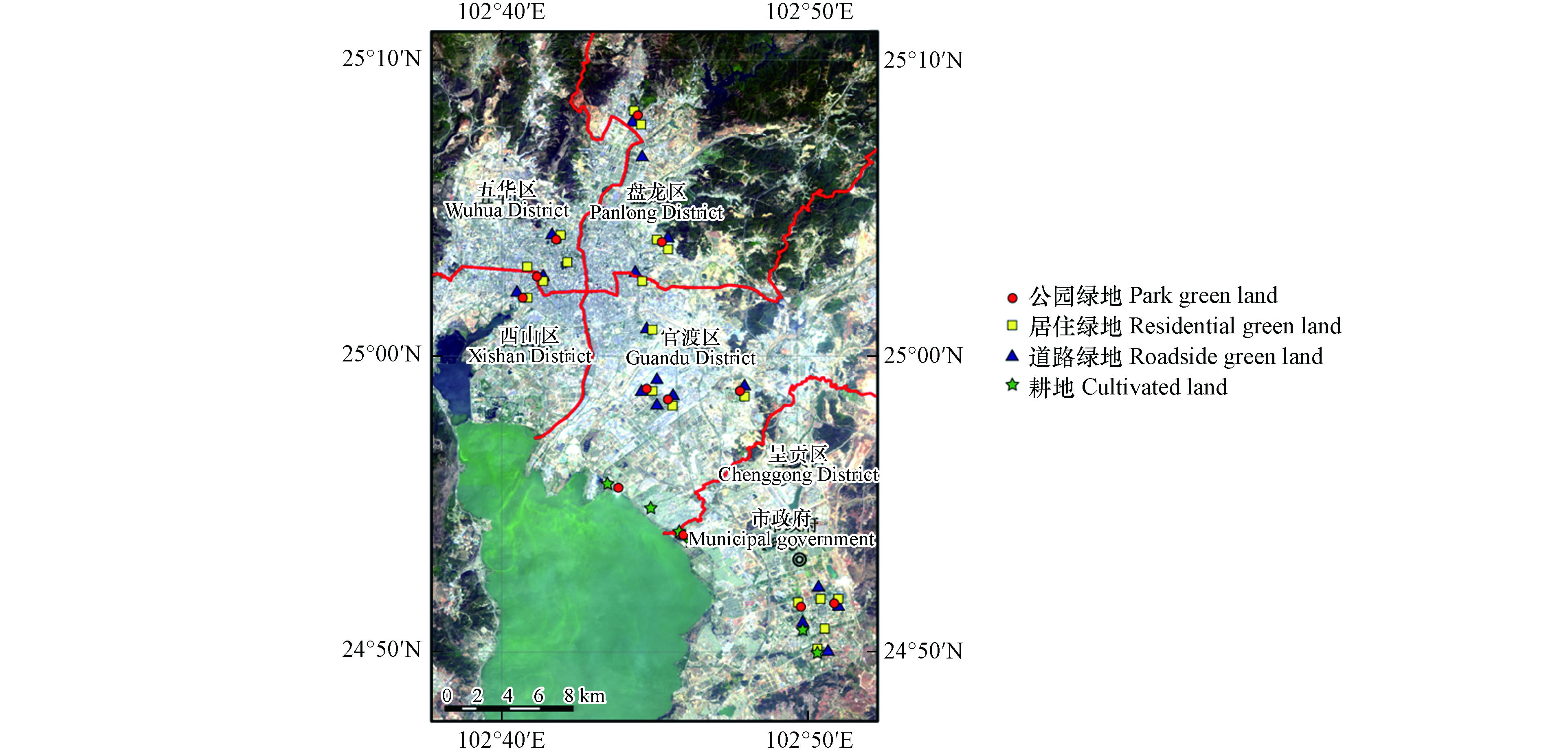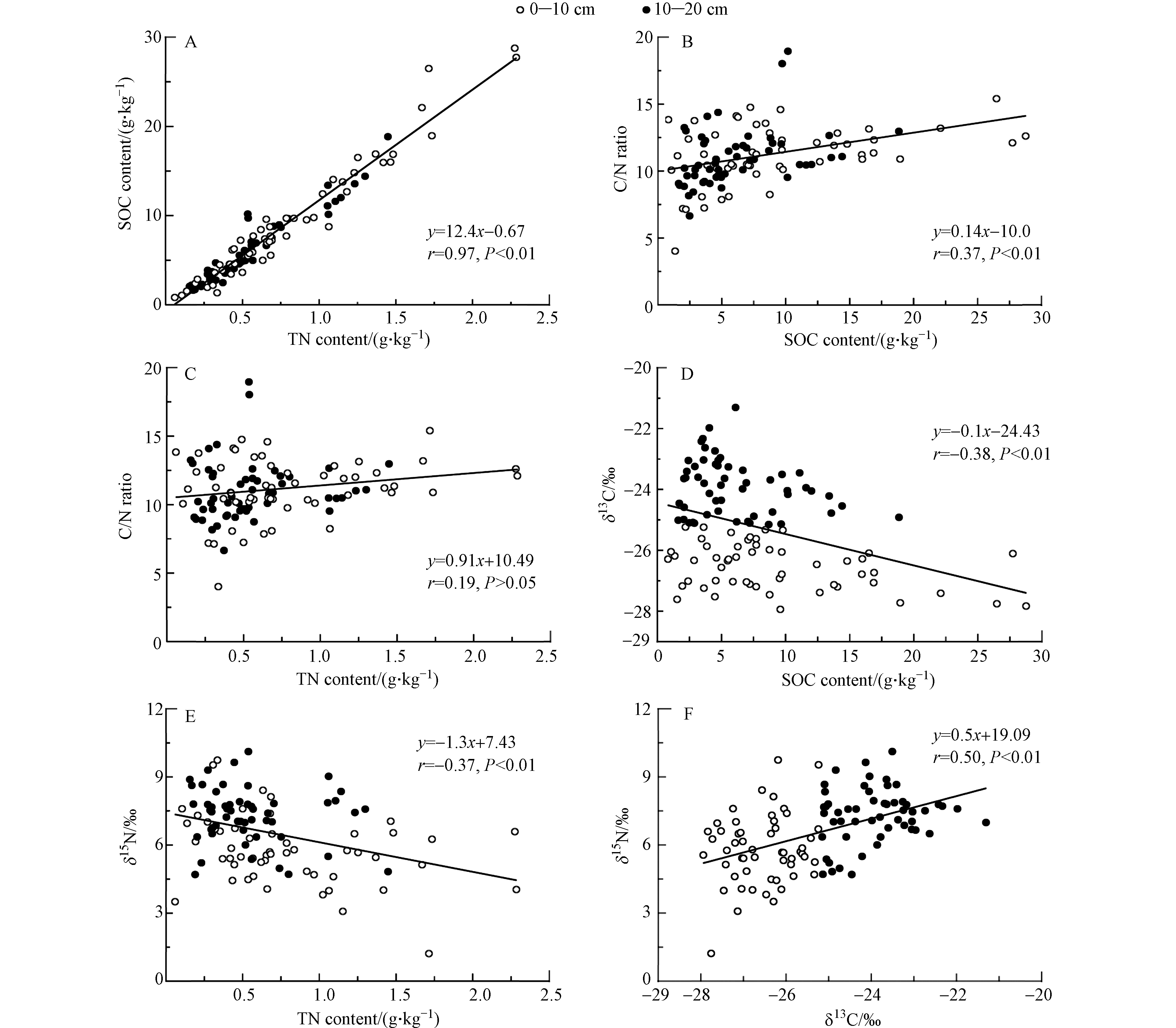-
土壤作为陆地生态系统的重要组成部分,是诸多生态过程的载体,其碳、氮循环因与全球变化密切相关而成为当前研究的热点[1]. 土壤碳库约占到陆地生态系统碳的2/3,是关注全球气候变化的重要指标[2]. 氮作为一种重要的生命元素,一直是生物地球化学循环过程研究的重点[3]. 近年来随着经济的快速增长和城镇化快速推进,城市土壤在陆地生态系统中的重要性不断上升. 相对于其它陆地生态系统,城市土壤碳氮循环研究仍处于起步阶段,城市化占用了越来越多的自然用地和农业用地,对土壤碳氮循环过程的影响日益受到关注[4]. 表层土壤(如0—20 cm)是受人类活动影响最为频繁的区域,其有机质更容易受到土地利用类型和农业活动等人为因素影响而发生明显变化[5 − 6]. 因此,揭示土地利用方式与土壤养分及有机碳氮的关系,对城市生态安全与环境管理具有重要意义.
土壤有机碳(SOC)、氮(TN)含量及其动态平衡直接影响着土壤肥力和林地生产力[7]. 不同土地利用类型下土壤植被种类不同以及受人为活动影响程度差异,导致有机质的输入和分解状况不同,进而影响土壤碳、氮含量的变化[8 − 10]. 钟聪等[5]研究表明,人为活动会在很大程度上掩盖气候等自然因素对土壤有机质的影响. 同时,受人为活动影响的土地利用和植被恢复是土壤有机碳变化的主导因素[11]. 刘涛泽等[12]进一步探讨了土壤侵蚀和沉积过程中有机碳的动态变化和影响因素. Li等[13]对我国南方不同土地利用类型土壤的化学计量学研究表明,土壤C/N比值呈水田高于旱地和林地的特征.
环境中元素丰度与稳定同位素组成相结合研究往往可以提供更为详细的有关生物地球化学循环和营养源的信息[14 − 15]. 国内外研究表明,碳同位素值(δ13C)在示踪土壤有机质组份来源及评估其分解状况、认识古植被的历史变化与气候的关系等方面已有广泛应用[16],而氮同位素值(δ15N)的变化特征能够指示土壤有机质氮素的主要来源[17]. 廖宇琴等[18]和李龙波等[19]利用土壤有机质稳定碳、氮同位素技术揭示了土壤碳、氮循环过程中有机碳和氮的动态变化以及迁移转化规律. 然而,土壤有机质δ13C的深度分布具有明显区域性特征且变化非常复杂,在利用有机质的稳定碳同位素组成研究土壤有机质分解程度和土壤碳周转时,应该充分考虑区域性因素[20]. 土壤δ15N被认为是气候环境变化和自然生态系统氮循环过程的可能指示,除受植被类型影响外,还受土壤的理化性质、硝化作用以及农业施肥活动等因素共同影响[21 − 22]. 尽管前人对我国不同地区土壤有机质的研究取得一系列成果,但主要集中在东部和中部经济发达地区,对于生态环境脆弱区(如西南喀斯特地区)的研究较为薄弱[23 − 24];同时针对城市土壤碳氮元素丰度与其稳定同位素组成之间的耦合关系仍缺乏深入研究.
云南昆明是中国主要的喀斯特地貌分布区,近几十年来进行了大规模的开发建设,导致城区土地利用发生变化,对喀斯特地区的土壤性质和碳、氮循环产生了重要影响. 为探究不同土地利用类型下城市土壤如何响应自然和人为干扰,本研究以昆明市城区4种土地利用类型土壤为对象,分析土壤有机碳氮元素及其同位素的空间分布特征,探讨城区不同土地利用类型土壤生源要素的来源和迁移转化过程. 研究结论有助于为中国西南喀斯特地区城市土壤有机质的地球化学循环和土壤质量提供科学依据和数据支撑.
-
云南省昆明市(102°10'—103°40'E,24°23'—26°22'N)位于云贵高原中部,三面环山,南濒滇池. 区内石灰岩广布,属典型的喀斯特地貌. 市区大部分地区海拔在1900 m左右,属低纬亚热带高原山地季风气候,日照长、霜期短. 年平均气温14.9 ℃,年均降水量1011.2 mm,5—10月为雨季,降水量占全年的85%左右,11月至次年4月为干季. 昆明市以山原红壤为基带土壤,主要是石灰岩母质发育形成,脱硅富铝化作用不及砖红壤、砖红壤性红壤,自然土壤剖面主要发育有红泥、磷砂土、瘦红泥等. 城区由于受到人为改造,植物群落结构较为简单,常见乔木主要有云南松(Pinus yunnanensis)、银杏(Ginkgo biloba)、侧柏(Platycladus orientalis)、龙柏(Sabina chinensis)、鹅掌楸(Liriodendron chinense)、云南樟(Cinnamomum glanduliferum)、高盆樱桃(Cerasus cerasoides)等,常见灌木主要有紫叶李(Prunus cerasifera f. atropurpurea)、叶子花(Bougainvillea spectabilis)、大叶黄杨(Buxus megistophylla)等,常见草本植物主要有白车轴草(Trifolium repens)、红花酢浆草(Oxalis corymbosa)、吊竹梅(Tradescantia zebrina)等. 本研究涉及盘龙区、五华区、西山区与官渡区4个昆明市主城区,再加上近年来迅速发展建设的呈贡新区,总面积约2542 km2(图1).
-
根据昆明不同土地利用类型的区域分布状况,选择典型区域进行采样. 于2019年3月至7月,按照全国土地利用分类(GB/T 21010-2017)和城市绿地分类标准(CJJ/T85-2017),并基于人类活动影响强度或影响方式的不同,划分出4种土地利用类型的土壤进行采集(采样点间隔为200 m以上),包括公园绿地、居住绿地、道路绿地、耕地[9]. 公园绿地一般成土时间较长,且受人类活动影响相对较小,是4种土地利用中最接近自然土壤的类型,植被以高大乔木为主,部分地面有草本植物覆被,植被郁闭度较高. 居住绿地泛指人流量较密集的居民区、商场、医院、学校在内的绿化区域,植被以乔木、灌木为主,草本植物较少,受人类活动影响较大如除草、修剪整形、病虫害防治等. 道路绿地指城市道路两侧、中央隔离带受汽车尾气影响较大且灰尘较多的绿化带,有低矮乔木和灌丛生长. 耕地以种植农作物(含蔬菜)及花卉为主,受人类活动影响强度在4种土地利用类型中最大,如施肥、喷洒农药、犁耕、灌溉、轮作、秸秆还田等,耕作土相对松散,含水较多,不板结. 采样同时记录样点地理位置、海拔、土壤性质和植被类型信息.
本次共选取54个土壤采样点位,其中公园绿地12个,居住绿地19个,道路绿地17个,耕地6个,采样点位尽量选择覆盖昆明不同主城区. 每个点位周边10 m范围内划了3个样点进行采样,采样深度为20 cm,以10 cm间距分层采样,然后将3个相同层位的样品混合,得到该采样点位0—10 cm和10—20 cm样品各1个,每个样品重量在200 g以上. 采样时先用铲子拨去土壤表层的枯枝落叶,挖掘好后由深至浅进行分层采样避免污染样品,同时尽量避开混杂其中的植物根系与岩石碎屑[25]. 最终获得0—10 cm和10—20 cm土壤样品共108个. 除耕地土壤颜色为灰色外,其余各土地利用类型的土壤特征相似,以棕红色为主,向下表层根系逐渐减少,土壤颜色均一. 采集的土样均做好野外记录,装入袋内保存,带回实验室烘干处理.
-
将干燥后的土样混合均匀,从中称取0.5 g左右样品进行研磨,并过200目筛,用10%稀盐酸酸化处理至少48 h以上,然后用蒸馏水洗涤至中性,置于烘箱中在60 ℃下烘干后包入锡囊中待测. 经过前处理的样品用美国Thermo Scientific的MAT253气体稳定同位素比质谱仪联用Flash EA元素分析仪,采用快速燃烧法测定样品碳、氮同位素组成(δ13C、δ15N)和土壤有机碳(SOC)、总氮(TN)含量[26]. 稳定碳、氮同位素由国际通用标准形式给出:
式中,X表示13C或15N,Rsample为样品13C/12C或15N/14N,Rstandard为标样13C/12C或15N/14N,分析精度<0.1‰. 样品测试在云南省高原地理过程与环境变化重点实验室完成.
-
进行统计分析前对数据进行正态分布检验与数据转换的预处理,应用Student's t-test检验方法进行差异显著性检验,所有统计分析在SigmaPlot10.0、SPSS22.0和OriginPro9.1中进行,本文元素含量数据和C/N值以中值表示,稳定同位素组成数据为平均值±标准差.
-
昆明城市土壤SOC含量变化范围较大,为0.83—28.76 g·kg−1,变异系数74.2%,中值为6.14 g·kg−1. 按Van Bemmelen因数1.724计算,昆明城区土壤有机质含量为10.59 g·kg−1,位于全国第二次土壤普查养分分级标准[27]四级,属于中等偏低水平. 城市土壤TN含量较低,变异系数67.2%,中值仅为0.55 g·kg−1(图2),为分级标准[27]的五级水平. 与我国32个城市绿地土壤的调查结果[28]相比,昆明市土壤有机质含量较全国城市平均水平低27.22%,TN含量低28.57%. 前人研究表明,土壤有机质含量与有机物的输入量密切相关[29]. 过去20年是昆明城市化进程快速发展阶段,土地利用方式发生巨大改变,城市扩张占用了原市区周边肥沃的耕地. 同时,除昆明老城区,如呈贡新区、北市区的多数绿化带绿化年限短,成土时间不长,土壤养分相对贫瘠,有机质含量偏低,造成昆明土壤SOC、TN含量普遍低于长江中下游及华北平原等东部沿海城市化进程较早的地区[30 − 31].
凋落物的腐殖化速率也是影响昆明城市土壤有机质含量低的重要原因[29]. 昆明市绿化植物多为常绿植物,如云南松(Pinus yunnanensis)、云南樟(Cinnamomum glanduliferum)、大叶黄杨(Buxus megistophylla)等. 常绿植物凋落物相对难以分解,分解常数低于落叶植物[32],并且昆明市平均海拔近2000 m,年均气温低,微生物数量少,酶的活性较弱,抑制了凋落物腐殖化. 再加上城市环卫工人对凋落物的及时清扫,很大程度上减少了凋落物向土壤有机质转化的时间. 此外,昆明市区广泛分布的红泥和瘦红泥土种,在腐殖质层(0—25 cm)上属于砂质黏壤土,屑粒状结构,疏松,其砂质土壤团粒稳定性差,不利于有机质的保护[33]. 因此,昆明土壤有机质含量总体较低既有有机物输入量如土地利用方式改变、环卫工人作业的人为因素,也有有机质分解速率如昆明市气候、土质及植被类型等自然因素的影响.
从土地利用类型上看,公园绿地、居住绿地、道路绿地土壤SOC、TN含量变异系数较大(图2),公园绿地SOC、TN含量中值分别为6.21 g·kg−1和0.47 g·kg−1,居住绿地为5.27 g·kg−1和0.56 g·kg−1,道路绿地为5.75 g·kg−1和0.55 g·kg−1,3种土地利用类型之间差异不显著(P>0.05). 耕地土壤SOC、TN含量变化幅度最小,中值分别为11.81 g·kg−1和1.12 g·kg−1,约2倍于其他3种土地利用类型土壤. 耕地土壤较高的有机质含量主要是由于昆明的耕地土壤成土时间长,且增施化肥、秸秆还田、翻耕等措施有效改善了土壤条件使得耕地土壤有机质含量提高. 昆明城市不同土地利用类型土壤较大的有机碳氮含量变异系数表明,城市土壤受土地利用类型、人类活动强度、成土时间等多方面的影响,导致有机质的输入和分解速率存在一定差异,造成小区域尺度内有机质含量的巨大变化,这也是城市土壤有别于自然土壤的主要特征之一.
在垂直分布上,0—10 cm的SOC、TN含量分别为7.71 g·kg−1和0.68 g·kg−1,显著高于10—20 cm的SOC(4.59 g·kg−1,P<0.01)和TN(0.45 g·kg−1,P<0.01)含量(图2). 其中,公园绿地0—10 cm土壤SOC、TN含量略高于10—20 cm(P= 0.24,P=0.21),居住绿地、道路绿地0—10 cm土壤SOC、TN含量显著高于10—20 cm(P<0.05),而耕地土壤0—10 cm与10—20 cm的有机质含量较相近,在垂直分布上无明显差异(P>0.05). 总体而言,除耕地土壤外,各土地利用类型土壤SOC、TN含量随土层深度的增加而显著降低. 凋落物分解产物是土壤SOC、TN的重要来源[34],它们首先富集于地表,而后随水分或其它介质向下层扩散迁移,并且保持在相对稳定的含量[35],从而形成随土层深度的增加而降低的分布格局. 耕地土壤由于受人类活动影响强烈,如翻耕或耙地等土壤耕作方法使得上部的土壤混合,破坏土壤理化性质的分层特征.
针对不同土地利用类型土壤的研究结果可以看出,昆明在未来土地利用管理上,应优化土地利用类型的长期规划,强调土地利用类型调整与土壤成土时间的关系,重视植物凋落物对土壤养分的重要性,以增加土壤的养分.
-
昆明土壤有机质δ13C平均值为−25.22‰±1.56‰,变异系数6.2%. 公园绿地、居住绿地和道路绿地土壤的δ13C值较接近,而耕地的最高,平均值为−24.14‰±0.47‰(P=0.08)(图2). 在垂直分布上,0—10 cm的土壤有机质δ13C值为−25.70‰±1.49‰,显著低于10—20 cm的δ13C值(−24.76‰±1.48‰,P<0.01). 公园绿地、居住绿地土壤有机质在0—10 cm的δ13C值总体低于10—20 cm,但不存在显著性差异(P>0.05). 而道路绿地土壤0—10 cm有机质δ13C值显著低于10—20 cm(P<0.05),耕地土壤0—10 cm和10—20 cm有机质δ13C值接近,在垂直分布上差异不显著(P>0.05)(图2).
土壤的碳稳定同位素能够反映当地C3与C4植被的相对丰度[36]. 不同光合类型植物的有机碳δ13C值有确定的分布范围,C3型植物δ13C值范围为−23‰—−35‰,平均值约为−27‰,而C4型植物有机碳δ13C值范围为−9‰—−19‰,平均值约为-13‰[37]. 昆明土壤有机质δ13C值为−25.22‰±1.56‰,显著低于C4植物δ13C值而与C3植物的相近,指示研究区C3植物占绝对优势,与昆明现代植被调查结果[38]一致. 区域对比上,昆明土壤有机碳δ13C值显著低于广西环江县喀斯特地区(-19.95‰)[12],而与贵州龙里县喀斯特地区的(−24.33‰)接近[20]. C3、C4植物覆盖度差异可能是导致中国南方喀斯特地区土壤有机质δ13C值差异的原因之一. 广西环江县海拔较低,年平均气温可达19.9 ℃,而昆明和贵州龙里县年平均气温分别为14.9 ℃和14.8 ℃. 环江县研究区较高的年均温以及人为破坏导致的基岩裸露环境更有利于喜高温耐干旱的C4植物生长,土壤有机质δ13C值高. 而昆明、龙里县气候凉爽,年均温度低,更有利于C3植物的生长,造成土壤有机质δ13C值偏低. 昆明不同土地利用类型土壤的δ13C值并不存在显著差异,指示人类活动对土壤δ13C值影响较小,主要是受控于气候影响下的C3与C4植被覆盖度.
昆明城市土壤δ15N平均值为6.55‰±1.58‰,变异系数24.1%(图2). 直方图显示(图3),δ15N值分布范围在1.22‰—10.12‰之间,极差为8.90‰,7‰—8‰区间分布频数为32,占29.6%,峰度为0.35,偏态系数为-0.31,呈负偏态分布. 从土地利用类型上看,耕地δ15N值在4种土地利用类型中最高,平均值为8.03‰±0.58‰(P<0.05)(图2). 在垂直分布上,0—10 cm的土壤有机质δ15N值为6.17‰±1.62‰,显著低于10—20 cm的6.92‰±1.46‰(P<0.05),而耕地土壤δ15N在垂直分布上差异不显著(P>0.05)(图2).
与δ13C不同,昆明市区土壤δ15N值相较于黄土高原中西部(-1.2‰—5.8‰)[39]、重庆青木关岩溶区(3.40‰—4.79‰)[21]、黄河源区高寒草甸(3.37‰—4.69‰)[40]、鄱阳湖湿地(3.27‰—6.84‰)[17]等自然土壤剖面具有更广的分布范围以及更加富集重同位素15N. 土壤氮同位素具有示踪上覆植被利用不同氮源的能力,体现了氮源信息和氮的地球化学过程[17, 26]. 前人研究表明,化肥和工业废水的δ15N为-4‰—4‰[41],人类生活废水、粪肥的δ15N为10‰—20‰[42]. 昆明土壤较大的δ15N值分布范围表明,不同土地利用类型土壤受人类活动影响程度和方式存在空间异质性,未受人类活动影响或受化肥和工业废水污染的土壤具有较低的δ15N值[41],而受人类生活废水、粪肥污染的土壤则具有较高的δ15N值[42]. 总体较高的δ15N值表明,昆明市区土壤更多的是受到了城市生活污水的影响. 不同于自然剖面,城市绿化、市内公园绿地、近郊农田多以中水浇灌. 中水是由小区居民沐浴、盥洗和厕所等生活废水经集中处理后获得,具有相对较高的δ15N值[42]. 长期使用中水浇灌,植物吸收利用中水中δ15N值偏高的氮素,并通过凋落物分解进入土壤当中,最终导致土壤δ15N值整体偏高. 在4类土地利用类型土壤中,耕作土δ15N值最高,指示昆明近郊农田可能有使用氮同位素值较高的粪肥进行施肥,导致耕作土中15N在一定程度上富集. 昆明市区土壤δ15N值结果表明,人类活动已显著改变了城市中心及其郊区土壤氮同位素组成,使其显著有别于自然土壤. 因此,相较于碳同位素而言,土壤δ15N值更能作为人类活动影响的代用指标.
-
昆明不同土地利用类型城市土壤有机质C/N中值为10.89,且在垂直分布上变化较小,0—10 cm中值为11.08,10—20 cm中值为10.54,不存在显著差异(P<0.05)(图2). 相关性分析表明,昆明土壤中有机碳氮含量具有极显著的正相关关系(r=0.97,P<0.01),其线性回归方程的斜率为12.4(图4A),与全球48个不同研究区C/N为12.3的研究结果[43]相吻合,表明不同气候带、不同土地利用类型的土壤与植物体内C、N等生源要素之间的强耦合性. 垂向上土壤C/N值无显著性差异,指示在0—20 cm深度的土壤有机碳、氮元素的矿化速率大致相同,因而未出现C/N值的分异.
主成分分析(PCA)结果表明,第一主成分(PC1)的因子变量主要与SOC、TN含量相关,同时也与δ13C与δ15N有一定相关性,而C/N值主要受第二主成分(PC2)支配,表明PC1可能反映了城市土壤有机质含量变化,PC2则指示了土壤碳氮化学计量比特征. 土壤δ13C与δ15N的矢量线位于主轴一的负半轴,与SOC和TN矢量线方向相反,指示土壤稳定同位素组成受碳氮含量影响显著,SOC、TN含量降低会导致δ13C与δ15N升高(图5). 进一步利用Pearson相关分析发现,碳氮稳定同位素组成与对应的元素含量具弱相关性,δ13C值与SOC含量相关系数为-0.38(P<0.01),δ15N值与TN含量相关系数为-0.37(P<0.01). 此外,土壤δ13C值与δ15N值存在正相关关系(r=0.50,P<0.01),斜率小于1(图4F). 分析认为,土壤中SOC、TN含量越低,δ13C值和δ15N值越高,指示C、N生源要素及其对应的稳定同位素之间同样存在耦合关系,即有机质分解和矿质化过程中SOC、TN含量的降低是伴随着13C和15N的同步富集. 土壤中δ13C值的富集是由于不同有机质组分的矿化速率不同和有机质分解过程中碳同位素的分馏所致[44]. 而对于土壤中氮同位素,当氮从体系中流失时,土壤细菌的反硝化作用导致14N2O和14N2的损失大于15N2O和15N2的损失[45 − 47],最终造成土壤中15N的保留更为强烈. 在0—10 cm的土壤由于有新鲜的、13C和15N贫化的凋落物输入,使得在δ13C和δ15N水平上比10—20 cm土壤层显著偏低. 此外,土壤δ13C与δ15N值呈正向的协同变化且斜率小于1(图4F),表明土壤有机质降解过程中,δ15N的分馏程度高于δ13C. 因此,有机残体的矿质化过程是优先损失轻同位素的地球化学过程,造成残留的腐殖质富集重同位素,且15N的富集程度高于13C.
-
(1)受城市化进程、较短的绿化年限以及昆明自身的气候、植被类型等多因素影响,昆明城区土壤有机质、SOC、TN含量均低于全国城市平均水平. 不同土地利用类型土壤因人类活动影响强度差异而具有不同的碳氮含量,受人类活动影响强度最大的耕地土壤SOC、TN含量为其他3类土地利用类型的2倍. 有机碳氮含量较大的空间异质性是城市土壤不同于自然土壤的主要特征.
(2)昆明土壤δ13C值偏低与昆明独特气候背景影响下高C3植物覆盖度有关,与人类活动关系较小. δ15N值则受城市中水灌溉而呈现总体更富集15N的分布特征,表明人类活动已显著影响城市土壤氮素循环过程. 同时,土壤有机碳氮元素含量与其对应的稳定同位素之间存在紧密的耦合关系,土壤有机质的分解、矿质化会对碳、氮同位素产生分馏作用,导致重同位素13C、15N在残留的土壤腐殖质中富集,并且15N的富集程度更高.
昆明城市土壤有机碳氮含量及其稳定同位素耦合关系研究
Coupling relationship of urban soil organic carbon and nitrogen contents with isotopes in Kunming urban area
-
摘要: 随着城镇化的快速推进,城市土壤已成为陆地生态系统重要组成部分,不同土地利用类型土壤有机碳氮含量、稳定同位素组成分布特征及其耦合关系是了解城市土壤碳氮循环过程的重要途径. 选取昆明市区受人类活动影响程度不同的公园绿地、居住绿地、道路绿地、耕地4类土壤作为研究对象,开展0—20 cm土壤有机质碳氮元素及其同位素组成的空间分异特征与影响因素研究. 结果表明,昆明城市土壤有机质含量低,有机碳(SOC)和总氮(TN)含量中值分别为6.14 g·kg−1和0.55 g·kg−1,较全国城市土壤平均水平低27.22%(C)和28.57%(N). 土壤有机碳同位素(δ13C)平均值为-25.22‰±1.56‰,氮同位素(δ15N)则分布范围较广,为1.22‰—10.12‰,平均值为6.55‰±1.58‰,显著高于其他自然土壤δ15N值. 4类土地利用类型中,耕地土壤SOC、TN含量显著偏高,δ13C和δ15N值显著偏正. 垂向分布上,公园绿地、居住绿地、道路绿地SOC、TN含量随土层深度的增加而降低,δ13C和δ15N值则呈现富集趋势,表明重同位素13C、15N在土壤腐殖质中富集. 耕地土壤因人为耕作,理化性质分层特征不明显. 昆明市较低的土壤有机质含量与城市化进程导致的土地利用类型改变、绿化年限影响的成土时间较短以及昆明市气候、土质、植被类型等多因素有关. 昆明城市土壤δ13C值主要受昆明C3、C4植被覆盖度等自然环境因素影响,而δ15N值由于受城市中水灌溉影响,显著偏正于自然土壤,指示人类活动已显著改变城市土壤氮循环过程,使土壤中更富集重同位素15N. 不同土地利用类型土壤垂向分布特征揭示有机质的分解、转化过程会对碳、氮同位素产生分馏作用,且氮同位素分馏高于碳同位素的分馏.Abstract: With the rapid development of urbanization, urban soils have become an important part of terrestrial ecosystem. Stoichiometric and stable isotope compositions of soil organic carbon and nitrogen provide a unique insight into the carbon and nitrogen cycling of urban soils under different land uses. Here, four types of soil profiles, including park green land, residential green land, roadside green land and cultivated land, which were typical of urban soils in Kunming, were selected to uncover the spatial variation and drivers of carbon and nitrogen elements and their isotopic compositions in top soils (0—20 cm). The soil organic content was relatively low, with a median value of 6.14 g·kg−1 for soil organic carbon (SOC) and 0.55 g·kg−1 for total nitrogen (TN), which were 27.22% and 28.57% lower than the national urban average, respectively. Soil δ13C was significantly depleted, with an average value of -25.22‰ ± 1.56‰. While the variation of urban soil δ15N was large, ranging from 1.22‰ to 10.12‰ and with an average value of 6.55‰ ± 1.58‰, which was significantly higher than those of other natural soils. Among the four soil types, the content of SOC and TN in cultivated lands was significantly higher, with a significant enrichment in δ13C and δ15N signals. Over the soil profile, SOC and TN in park green land, residential green land and roadside green land all decreased with an increasing depth, meanwhile δ13C and δ15N values showed a trend of enrichment. Due to frequent ploughing disturbances, the stoichiometry and stable isotope of cultivated soils had no significant change in the vertical profile. Relatively low content of soil organic matter in our study region might be related to multiple anthropogenic factors, such as the change of land use type caused by urbanization, the short soil development time affected by greening practice, and the monsoon climate, soil quality, and vegetation. In comparison, soil δ13C value was mainly affected by natural factors such as C3 and C4 vegetation coverage. Possibly affected by urban reclaimed water irrigation, the δ15N value of Kunming urban soil was significantly higher than that of natural soils, indicating that human activities have significantly changed the nitrogen cycling of urban soils. Profile characteristics of soils across different land use types indicated that decomposition and mineralization of organic matter would induce fractionation of carbon and nitrogen isotopes, resulting in the enrichment of 13C and 15N signals in residual soil humus, as well as a stronger isotope fractionation for nitrogen than that for carbon.
-
Key words:
- urban soil /
- organic carbon /
- total nitrogen /
- stable isotope /
- land-use type /
- Kunming.
-

-
-
[1] YANG Y H, SHI Y, SUN W J, et al. Terrestrial carbon sinks in China and around the world and their contribution to carbon neutrality[J]. Science China-Life Sciences, 2022, 65(5): 861-895. doi: 10.1007/s11427-021-2045-5 [2] LAL R. Soil carbon sequestration impacts on global climate change and food security[J]. Science, 2004, 304(5677): 1623-1627. doi: 10.1126/science.1097396 [3] BINGHAM A H, COTRUFO M F. Organic nitrogen storage in mineral soil: Implications for policy and management[J]. Science of the Total Environment, 2016, 551/552: 116-126. doi: 10.1016/j.scitotenv.2016.02.020 [4] LORENZ K, LAL R. Biogeochemical C and N cycles in urban soils[J]. Environment International, 2009, 35(1): 1-8. doi: 10.1016/j.envint.2008.05.006 [5] 钟聪, 李小洁, 何园燕, 等. 广西土壤有机质空间变异特征及其影响因素研究[J]. 地理科学, 2020, 40(3): 478-485. ZHONG C, Li X J, He Y Y, et al. Spatial variation of soil organic matter and its influencing factors in Guangxi, China[J]. Scientia Geographica Sinica, 2020, 40(3): 478-485(in Chinese).
[6] 王艺杰, 于丽君, 张稳, 等. 造林后表层土壤有机碳变化及影响因素分析[J]. 地理与地理信息科学, 2022, 38(2): 103-111. WANG Y J, YU L J, ZHANG W, et al. Analysis on changes of topsoil organic carbon after afforestation and the influencing factors[J]. Geography and Geo-Information Science, 2022, 38(2): 103-111(in Chinese).
[7] TEWKSBURY C E, VAN MIEGROET H. Soil organic carbon dynamics along a climatic gradient in a southern Appalachian spruce–fir forest[J]. Canadian Journal of Forest Research, 2007, 37(7): 1161-1172. doi: 10.1139/X06-317 [8] PETER P C. Soil organic matter/carbon dynamics in contrasting tillage and land management systems: A case for smallholder farmers with degraded and marginal soils[J]. Communications in Soil Science and Plant Analysis, 2017, 48(17): 2013-2031. doi: 10.1080/00103624.2017.1406099 [9] 张青青, 伍海兵, 梁晶. 上海市绿地表层土壤有机碳储量的估算[J]. 土壤, 2020, 52(4): 819-824. ZHANG Q Q, WU H B, LIANG J. Estimation of storage of organic carbon in green surface soils in Shanghai[J]. Soils, 2020, 52(4): 819-824(in Chinese).
[10] FELIPE-LUCIA M R, SOLIVERES S, PENONE C, et al. Land-use intensity alters networks between biodiversity, ecosystem functions, and services[J]. Proceedings of the National Academy of Sciences of the United States of America, 2020, 117(45): 28140-28149. [11] ZHAO B H, LI Z B, LI P, et al. Spatial distribution of soil organic carbon and its influencing factors under the condition of ecological construction in a hilly-gully watershed of the Loess Plateau, China[J]. Geoderma, 2017, 296: 10-17. doi: 10.1016/j.geoderma.2017.02.010 [12] 刘涛泽, 刘丛强, 张伟, 等. 喀斯特地区坡地土壤有机碳的分布特征和 δ13C值组成差异[J]. 水土保持学报, 2008, 22(5): 115-118, 124. LIU T Z, LIU C Q, ZHANG W, et al. Spatial distribution characteristics of soil organic carbon and difference in stable carbon isotope composition in slopes of Karst areas[J]. Journal of Soil and Water Conservation, 2008, 22(5): 115-118, 124(in Chinese).
[13] LI Y, WU J S, LIU S L, et al. Is the C: N: P stoichiometry in soil and soil microbial biomass related to the landscape and land use in southern subtropical China? [J]. Global Biogeochemical Cycles, 2012, 26(4): GB4002. [14] 郭雯, 黄林培, 王明果, 等. 不同组织碳、氮元素含量和同位素分馏特征研究: 以抚仙湖草鱼、鱇浪白鱼为例[J]. 中国环境科学, 2022, 42(1): 345-355. GUO W, HUANG L P, WANG M G, et al. Carbon and nitrogen contents and isotopic fractionation in different tissues of Ctenopharyngodon idellus and Anabarilius grahami in Fuxian Lake[J]. China Environmental Science, 2022, 42(1): 345-355(in Chinese).
[15] WANG X Y, ZHAO L X, COMEAU L P, et al. Divergent carbon stabilization pathways in aggregates in Ultisols with and without organic amendments: Implications from 13C natural abundance and NMR analysis[J]. Geoderma, 2022, 426: 116088. doi: 10.1016/j.geoderma.2022.116088 [16] 于贵瑞, 王绍强, 陈泮勤, 等. 碳同位素技术在土壤碳循环研究中的应用[J]. 地球科学进展, 2005, 20(5): 568-577. YU G R, WANG S Q, CHEN P Q, et al. Isotope tracer approaches in soil organic carbon cycle research[J]. Advances in Earth Science, 2005, 20(5): 568-577(in Chinese).
[17] 王毛兰, 赖建平, 胡珂图, 等. 鄱阳湖湿地土壤有机碳氮同位素特征及其环境意义[J]. 中国环境科学, 2016, 36(2): 500-505. WANG M L, LAI J P, HU K T, et al. Compositions of stable organic carbon and nitrogen isotopes in wetland soil of Poyang Lake and its environmental implications[J]. China Environmental Science, 2016, 36(2): 500-505(in Chinese).
[18] 廖宇琴, 龙娟, 木志坚, 等. 重庆农田土壤有机碳稳定性同位素空间分布特征[J]. 环境科学, 2022, 43(6): 3348-3356. LIAO Y Q, LONG J, MU Z J, et al. Spatial characterization of stable isotope composition of organic carbon from farmland soils in Chongqing[J]. Environmental Science, 2022, 43(6): 3348-3356(in Chinese).
[19] 李龙波, 涂成龙, 赵志琦, 等. 黄土高原不同植被覆盖下土壤有机碳的分布特征及其同位素组成研究[J]. 地球与环境, 2011, 39(4): 441-449. LI L B, TU C L, ZHAO Z Q, et al. Distribution characteristics of soil organic carbon and its isotopic composition for soil profiles of Loess Plateau under different vegetation conditions[J]. Earth and Environment, 2011, 39(4): 441-449(in Chinese).
[20] 朱书法, 刘丛强, 陶发祥, 等. 喀斯特地区土壤有机质的稳定碳同位素地球化学特征[J]. 地球与环境, 2006, 34(3): 51-58. ZHU S F, LIU C Q, TAO F X, et al. Geochemical characteristics of stable carbon isotopes in soil organic matter from karst areas[J]. Earth and Environment, 2006, 34(3): 51-58(in Chinese).
[21] 汪智军, 梁轩, 贺秋芳, 等. 岩溶区不同植被类型下的土壤氮同位素分异特征[J]. 生态学报, 2011, 31(17): 4970-4976. WANG Z J, LIANG X, HE Q F, et al. Differential characteristics of soil δ15N under varying vegetation in karst areas[J]. Acta Ecologica Sinica, 2011, 31(17): 4970-4976(in Chinese).
[22] BILLY C, BILLEN G, SEBILO M, et al. Nitrogen isotopic composition of leached nitrate and soil organic matter as an indicator of denitrification in a sloping drained agricultural plot and adjacent uncultivated riparian buffer strips[J]. Soil Biology and Biochemistry, 2010, 42(1): 108-117. doi: 10.1016/j.soilbio.2009.09.026 [23] 郭松, 王立发, 马海欧, 等. 滇东地区土壤剖面氮同位素垂直分异及空间分异特征[J]. 环境化学, 2018, 37(2): 279-286. doi: 10.7524/j.issn.0254-6108.2017061301 GUO S, WANG L F, MA H O, et al. Vertical distribution and spatial differentiation characteristics of nitrogen isotope in soil profile of Eastern Region of Yunnan Province[J]. Environmental Chemistry, 2018, 37(2): 279-286(in Chinese). doi: 10.7524/j.issn.0254-6108.2017061301
[24] 何高迅, 王越, 彭淑娴, 等. 滇中退化山地不同植被恢复下土壤碳氮磷储量与生态化学计量特征[J]. 生态学报, 2020, 40(13): 4425-4435. HE G X, WANG Y, PENG S X, et al. Soil carbon, nitrogen and phosphorus stocks and ecological stoichiometry characteristics of different vegetation restorations in degraded mountainous area of central Yunnan, China[J]. Acta Ecologica Sinica, 2020, 40(13): 4425-4435(in Chinese).
[25] 崔姗姗, 李占彬, 朱平, 等. 贵州遵义地区镉大气沉降通量与表层土壤分布特征[J]. 环境化学, 2022, 41(4): 1324-1334. doi: 10.7524/j.issn.0254-6108.2020122001 CUI S S, LI Z B, ZHU P, et al. Atmospheric deposition flux of cadmium and distribution characteristics of surface soil in Zunyi, Guizhou[J]. Environmental Chemistry, 2022, 41(4): 1324-1334(in Chinese). doi: 10.7524/j.issn.0254-6108.2020122001
[26] 陈蓉, 王明果, 黄林培, 等. 滇池浮游植物碳氮同位素时空分布特征及其影响因子分析[J]. 中国环境科学, 2022, 42(2): 843-853. CHEN R, WANG M G, HUANG L P, et al. Spatio-temporal distribution and influencing factors of stable carbon and nitrogen isotopes of phytoplankton in Dianchi Lake[J]. China Environmental Science, 2022, 42(2): 843-853(in Chinese).
[27] 全国土壤普查办公室. 中国土壤普查技术[M]. 北京: 农业出版社, 1992. National Soil Census Office. Soil census technology in China[M]. Beijing: Agricultural Publishing House, 1992(in Chinese).
[28] 张明, 潘国林, 张宗应, 等. 我国部分城市绿地土壤肥力质量分析与评价[J]. 内蒙古农业大学学报(自然科学版), 2019, 40(3): 46-51. ZHANG M, PAN G L, ZHANG Z Y, et al. Soil fertility quality analysis and evaluation in some urban green space of China[J]. Journal of Inner Mongolia Agricultural University (Natural Science Edition), 2019, 40(3): 46-51(in Chinese).
[29] 李忠佩, 张桃林, 陈碧云, 等. 红壤稻田土壤有机质的积累过程特征分析[J]. 土壤学报, 2003, 40 (3): 344-352. LI Z P, ZHANG T L, CHEN B Y, et al. Soil organic matter dynamics in a cultivation chronosequence of paddy fields in subtropical China[J]. Acta Pedologica Sinica, 2003, 40 (3): 344-352(in Chinese).
[30] 邬建红, 潘剑君, 葛序娟, 等. 不同土地利用方式下土壤有机碳矿化及其温度敏感性[J]. 水土保持学报, 2015, 29(3): 130-135. WU J H, PAN J J, GE X J, et al. Variations of soil organic carbon mineralization and temperature sensitivity under different land use types[J]. Journal of Soil and Water Conservation, 2015, 29(3): 130-135(in Chinese).
[31] 廖洪凯, 龙健, 李娟. 土地利用方式对喀斯特山区土壤养分及有机碳活性组分的影响[J]. 自然资源学报, 2012, 27(12): 2081-2090. LIAO H K, LONG J, LI J. Effects of different land use patterns on soil nutrients and soil active organic carbon components in karst mountain area[J]. Journal of Natural Resources, 2012, 27(12): 2081-2090(in Chinese).
[32] 黄锦学, 黄李梅, 林智超, 等. 中国森林凋落物分解速率影响因素分析[J]. 亚热带资源与环境学报, 2010, 5(3): 56-63. HUANG J X, HUANG L M, LIN Z C, et al. Controlling factors of litter decomposition rate in China’s forests[J]. Journal of Subtropical Resources and Environment, 2010, 5(3): 56-63(in Chinese).
[33] 李紫燕, 李世清, 李生秀. 黄土高原典型土壤有机氮矿化过程[J]. 生态学报, 2008, 28(10): 4940-4950. LI Z Y, LI S Q, LI S X. Organic N mineralization in typical soils of the Loess Plateau[J]. Acta Ecologica Sinica, 2008, 28(10): 4940-4950(in Chinese).
[34] FENG D F, BAO W K, PANG X Y. Consistent profile pattern and spatial variation of soil C/N/P stoichiometric ratios in the subalpine forests[J]. Journal of Soils and Sediments, 2017, 17(8): 2054-2065. doi: 10.1007/s11368-017-1665-9 [35] 陶晓, 俞元春, 张云彬, 等. 城市森林土壤碳氮磷含量及其生态化学计量特征[J]. 生态环境学报, 2020, 29(1): 88-96. TAO X, YU Y C, ZHANG Y B, et al. Carbon, nitrogen and phosphorus contents and their ecological stoichiometry in urban forest soil[J]. Ecology and Environmental Sciences, 2020, 29(1): 88-96(in Chinese).
[36] 王国安. 中国北方草本植物及表土有机质碳同位素组成[D]. 北京: 中国科学院地质与地球物理研究所, 2001. WANG G A. δ13C composition in herbaceous plants and surface soil organic matter in North China [D]. Beijing: Institute of Geology and Geophysics, Chinese Academy of Sciences, 2001 (in Chinese).
[37] O'LEARY M H. Carbon isotopes in photosynthesis[J]. BioScience, 1988, 38(5): 328-336. doi: 10.2307/1310735 [38] WANG Y H, YANG H, ZHANG J X, et al. Characterization of n-alkanes and their carbon isotopic composition in sediments from a small catchment of the Dianchi watershed[J]. Chemosphere, 2015, 119: 1346-1352. doi: 10.1016/j.chemosphere.2014.01.085 [39] 刘卫国, 王政. 黄土高原现代植物-土壤氮同位素组成及对环境变化的响应[J]. 科学通报, 2008, 53(23): 2917-2924. doi: 10.1360/csb2008-53-23-2917 LIU W G, WANG Z. Nitrogen isotopic compsition of plant-soil in the Loess Plateau and its responding to environmental change [J]. Chinese Science Bulletin, 2008, 53(23): 2917-2924(in Chinese). doi: 10.1360/csb2008-53-23-2917
[40] 全小龙, 段中华, 乔有明, 等. 不同高寒草甸土壤碳氮稳定同位素和密度的差异[J]. 草业学报, 2016, 25(12): 27-34. QUAN X L, DUAN Z H, QIAO Y M, et al. Variations in soil carbon and nitrogen stable isotopes and density among different alpine meadows[J]. Acta Prataculturae Sinica, 2016, 25(12): 27-34(in Chinese).
[41] HEATON T H E. Isotopic studies of nitrogen pollution in the hydrosphere and atmosphere: A review[J]. Chemical Geology: Isotope Geoscience Section, 1986, 59: 87-102. doi: 10.1016/0168-9622(86)90059-X [42] RUIZ-FERNÁNDEZ A C, HILLAIRE-MARCEL C, GHALEB B, et al. Recent sedimentary history of anthropogenic impacts on the Culiacan River Estuary, northwestern Mexico: geochemical evidence from organic matter and nutrients[J]. Environmental Pollution, 2002, 118(3): 365-377. doi: 10.1016/S0269-7491(01)00287-1 [43] CLEVELAND C C, LIPTZIN D. C: N: P stoichiometry in soil: is there a "Redfield ratio" for the microbial biomass? [J]. Biogeochemistry, 2007, 85(3): 235-252. doi: 10.1007/s10533-007-9132-0 [44] CHEN Q Q, SHEN C D, PENG S L, et al. Soil organic matter turnover in the subtropical mountainous region of South China[J]. Soil Science, 2002, 167(6): 401-415. doi: 10.1097/00010694-200206000-00005 [45] HÖGBERG P. Forests losing large quantities of nitrogen have elevated 15N: 14N ratios[J]. Oecologia, 1990, 84(2): 229-231. doi: 10.1007/BF00318276 [46] HU C C, LEI Y B, TAN Y H, et al. Plant nitrogen and phosphorus utilization under invasive pressure in a montane ecosystem of tropical China[J]. Journal of Ecology, 2019, 107(1): 372–386. doi: 10.1111/1365-2745.13008 [47] XU S Q, LIU X Y, SUN Z C, et al. Isotopic elucidation of microbial nitrogen transformations in forest soils[J]. Global Biogeochemical Cycles, 2022, 35(12): e2021GB007070. -




 下载:
下载:





